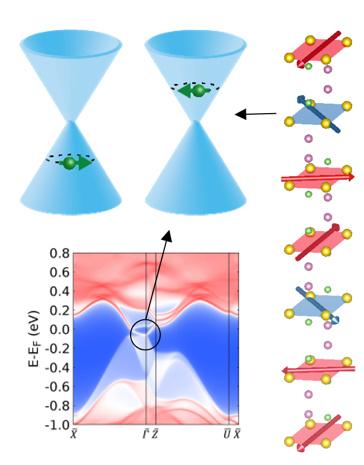A collaboration of scientists at the U.S. Department of Energy’s Center for the Advancement of Topological Semimetals led by Ames Laboratory, Oak Ridge National Laboratory, Harvard University, and McGill University have teamed with MURR scientist Tom Heitmann to discover the existence of low-symmetry helical magnetic ordering in EuIn2As2 which supports a highly sought-after topological state called an axion insulator. This state shares similarities with the axion particle in quantum chromodynamics which is a candidate component of dark matter. In solid-state materials, it provides remarkable parallel coupling between magnetic and electrical properties.

In the presence of EuIn2As2’s complex helical magnetic ordering, the axion state leads to topological features in the surface electronic spectrum called Dirac cones. When a Dirac cone occurs on a surface penetrated by a fundamental axis of the magnetic ordering, it is gapless and the surface exhibits resistanceless conduction tied to the orientation of the electronic spin. Other surfaces have gapped Dirac cones and support half-integer quantized electrical conduction. The research predicts that application of a relatively moderate magnetic field switches which surfaces support which type of conduction. The ability to switch between surface states by a magnetic field provides an experimental avenue to examine the unique properties of its topological states. This tunability is also promising for technologies such as high-precision sensors, resistanceless nanowires, magnetic storage media, and quantum computers.

The paper, “Magnetic crystalline-symmetry-protected axion electrodynamics and field-tunable unpinned Dirac cones in EuIn2As2,” is authored by S. X. M. Riberolles, T. V. Trevisan, B. Kuthanazhi, T. W. Heitmann, F. Ye, D. C. Johnston, S. L. Bud’ko, D. H. Ryan, P. C. Canfield, A. Kreyssig, A. Vishwanath, R. J. McQueeney, L. -L. Wang, P. P. Orth & B. G. Ueland; and published in Nature Communications.
https://www.nature.com/articles/s41467-021-21154-y
This research was supported by the Center for the Advancement of Topological Semimetals, an Energy Frontier Research Center funded by the U.S. Department of Energy Office of Science, and led by Ames Laboratory. This research used resources at the Spallation Neutron Source, a DOE Office of Science User Facility operated by the Oak Ridge National Laboratory. Financial support for this work was provided by Fonds Québécois de la Recherche sur la Nature et les Technologies.
Ames Laboratory is a U.S. Department of Energy Office of Science National Laboratory operated by Iowa State University. Ames Laboratory creates innovative materials, technologies and energy solutions. We use our expertise, unique capabilities and interdisciplinary collaborations to solve global problems.